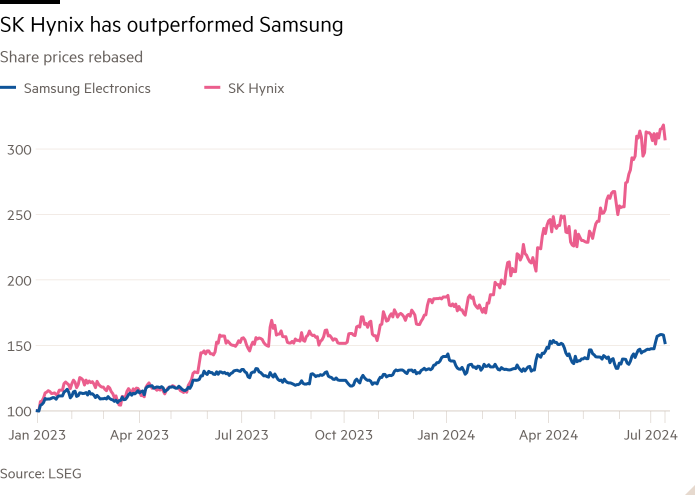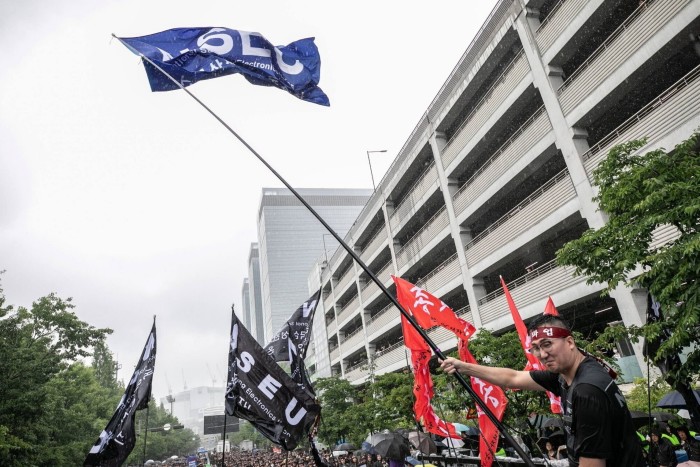Samsung Electronics is grappling with a growing labor crisis that is complicating its efforts to catch up with rivals in the booming market for semiconductors used in artificial intelligence systems.
The Korean tech giant delighted investors earlier this month by expecting second-quarter operating profits to rise nearly 1,500% from a year earlier, as the global memory market rebounds from a prolonged slump.
But the higher-than-expected forecast came amid growing employee discontent and chip production difficulties that have dragged the group down relative to rivals in areas seen as key to future growth. Samsung shares have risen about 7.5 percent this year, compared with a 65 percent gain for domestic rival SK Hynix.
Samsung follows SK Hynix and U.S. chipmaker Micron in developing high-bandwidth memory (HBM) chips, a crucial component of AI systems, and has yet to pass the tests required to qualify as an HBM supplier to industry leader Nvidia.
“This is extremely concerning for a company that has historically been the leading memory maker,” said Myron Xie, an analyst at SemiAnalysis, a chip consultancy. “HBM is a very profitable product, so Samsung is missing out on a big opportunity.”

Samsung also failed to dent TSMC’s dominance in the global foundry market – the contract manufacturing market for processor chips – despite optimism that big customers would seek to reduce their reliance on the Taiwanese chip giant amid heightened geopolitical risks.
“Although customers would like a second foundry alternative, the number one priority for customers is the quality of the technology and the ability to have a stable source of supply, which Samsung’s foundry has not provided,” Xie said.
In May, Samsung Chairman Lee Jae-yong abruptly appointed a new head of Samsung Electronics’ chip division, industry veteran Jun Young-hyun, who vowed to “renew the atmosphere internally and externally” to address a “chip crisis” within the company.
But a Samsung chip engineer, speaking on condition of anonymity, told the Financial Times that they “didn’t see much change, even after our boss was replaced.”
“The internal atmosphere is gloomy as we lag behind SK Hynix in HBM and fail to catch up with TSMC in foundry,” the engineer said.
“People are unhappy with their pay in general because they feel they are treated worse than their colleagues at SK Hynix,” they added. “Many people are considering leaving the company to join our competitors.”
Growing worker discontent was exposed last Monday when some 6,500 members of the Samsung Electronics National Union, which has grown from 10,000 to more than 30,000 in the space of a year, launched an unprecedented three-day strike.

The company, which unveiled its latest foldable smartphones with enhanced AI features on Wednesday, is also facing intense pressure from Apple and its lower-cost Chinese rivals in the mobile phone sector, while Chinese rivals also threaten to erode its market share in the display and home appliance sectors.
“Employee morale is low, discouraged by low pay,” said a researcher at Samsung’s smartphone division, also speaking on condition of anonymity. “They feel helpless because management seems disoriented.”
“I’ve always been used to sales growth, but this is the first time I’ve seen growth decline,” added a Samsung appliance salesperson, who also asked not to be named. “My team members feel a sense of crisis.”
Samsung has denied NSEU allegations that the three-day strike disrupted chip production. But on Wednesday, the union announced it would continue its “indefinite strike” that would target production lines, including those used to make HBM chips.
“Management has no intention of engaging in dialogue,” the union said in a statement. “We have clearly identified disruptions to online production and the company will regret this decision.”
Samsung said in a statement to the Financial Times that it “remains committed to engaging in good faith negotiations with the union,” but declined to comment on personnel matters. However, analysts said the strike would complicate efforts to catch up with SK Hynix in the race for HBM.
The two rivals are now in fierce competition for a limited pool of Korean engineering talent, according to a Samsung investor. Both companies declined to comment on the talent battle.
Samsung announced last week the creation of a cross-divisional team dedicated to HBM development efforts and is expected to eventually fill the technology gap on SK Hynix as the industry moves toward future generations of HBM chips, according to Nomura analyst CW Chung.
“If you adopt the wrong strategy and develop the wrong chip, its domino effects will last about three years,” Chung said, noting that the broader memory growth cycle would continue to boost the company’s profitability in the meantime. “But the worst seems to be behind the company now.”
Samsung says that as the only company with cutting-edge foundry and memory chip capabilities, as well as next-generation “advanced packaging” techniques, it will be well positioned to take on the emerging alliance between SK Hynix and TSMC, which are working closely on the next generation of AI chips.
“Our commitment to technological advancement and the scale of our investments have been and will continue to be at the heart of our success,” the company said. “We are confident and excited to navigate the current landscape and consolidate our leadership position.”
But SemiAnalysis’ Xie said that “being a one-stop shop is of little benefit to chip design companies when Samsung is not the best in any of the above aspects.”
“Given that Samsung has seen its technological capabilities erode in many areas of its business, it appears that some of the problems stem from the company’s leadership and culture,” he added. “A cultural reset may be long and painful, but it may be the best solution for the company in the long run.”